
The Church of Christ, Scientist was founded in 1879 in Boston, Massachusetts, by Mary Baker Eddy, author of Science and Health with Key to the Scriptures, and founder of Christian Science. The church was founded "to commemorate the word and works of Christ Jesus" and "reinstate primitive Christianity and its lost element of healing".
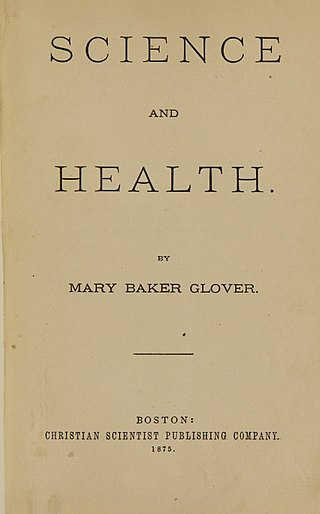
Science and Health with Key to the Scriptures, by Mary Baker Eddy, is, along with the Bible, one of the two central texts of the Christian Science religion. Eddy described it as her "most important work". She began writing it in February 1872, and the first edition was published in 1875. However, she would continue working on it and making changes for the rest of her life.

Mary Baker Eddy was an American religious leader and author who founded The Church of Christ, Scientist, in New England in 1879. She also founded The Christian Science Monitor in 1908, and three religious magazines: the Christian Science Sentinel, The Christian Science Journal, and The Herald of Christian Science. She wrote numerous books and articles, the most notable of which were Science and Health with Key to the Scriptures and Manual of The Mother Church. Other works were edited posthumously into the Prose Works Other than Science and Health.

Christian Science is a set of beliefs and practices which are associated with members of the Church of Christ, Scientist. Adherents are commonly known as Christian Scientists or students of Christian Science, and the church is sometimes informally known as the Christian Science church. It was founded in 19th-century New England by Mary Baker Eddy, who wrote the 1875 book Science and Health with Key to the Scriptures, which outlined the theology of Christian Science. The book became Christian Science's central text, along with the Bible, and by 2001 had sold over nine million copies.
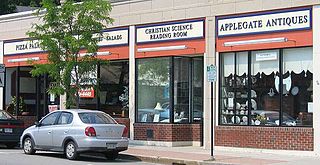
A Christian Science Reading Room is a facility operated as a public service by a Christian Science church in the community where that church exists. The local branches of The Mother Church in Boston, Massachusetts, maintain these rooms as a place where one may study and contemplate the Bible and Christian Science literature in a quiet atmosphere, similar to a library.

The Christian Science Publishing Society was established in 1898 by Mary Baker Eddy and is the publishing arm of The First Church of Christ, Scientist in Boston, Massachusetts.
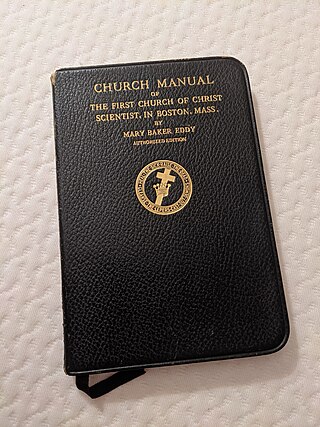
The Church Manual of The First Church of Christ, Scientist, in Boston, Massachusetts commonly known as the Manual of The Mother Church is the book that establishes the structure and governance of The First Church of Christ, Scientist, also known as The Mother Church, functioning like a constitution. It was written by Mary Baker Eddy, founder of the church. It was first published in 1895 and was revised dozens of times. The final edition, the 89th, was published in 1910.
Prose Works other than Science and Health with Key to the Scriptures, sometimes called Prose Works other than Science and Health or simply Prose Works, is a single-volume compendium of the major works of Mary Baker Eddy, the founder of Christian Science, outside of her main work, Science and Health with Key to the Scriptures. Also not included are Eddy's Church Manual, Poems, and Christ and Christmas. The books included in Prose Works were never published together as a single volume during her lifetime but were assembled as a convenience around 1925. When published it became the most popular book printed by the Christian Science Publishing Society besides Science and Health and the Church Manual. The constituent books have historically been published individually in parallel also. It has been issued in both hardcover and paperback.

Solon Spencer Beman was an American architect based in Chicago, Illinois and best known as the architect of the planned Pullman community and adjacent Pullman Company factory complex, as well as Chicago's renowned Fine Arts Building. Several of his other largest commissions, including the Pullman Office Building, Pabst Building, and Grand Central Station in Chicago, have since been demolished. Beman designed numerous Christian Science churches and influenced the design of countless more.

The Christian Science Plaza is a 13.5-acre (5.5 ha) site on the corner of Massachusetts Avenue and Huntington Avenue in the Fenway neighborhood of Boston, Massachusetts. The plaza, which is owned by the Church of Christ, Scientist, was designated as a Boston Landmark by the Boston Landmarks Commission in 2011, with the Commission describing it as a "heavily-used public space."

Augusta Emma Stetson was an American religious leader. Known for her impressive oratory skills and magnetic personality, she attracted a large following in New York City. However, her increasingly radical theories, conflicts with other church members including a well-known rivalry with Laura Lathrop, and attempts to supplant Mary Baker Eddy as the leader of The First Church of Christ, Scientist, led to her eventually being excommunicated from the church on charges of insubordination and of false teaching. Afterwards she began preaching and publishing various works on her theories which she named the "Church Triumphant," and started a controversial radio station to advance her cause.

The Dupee Estate, located at 400 Beacon Street in the village of Chestnut Hill, Newton, Massachusetts, was the last home of Mary Baker Eddy, the founder of Christian Science.
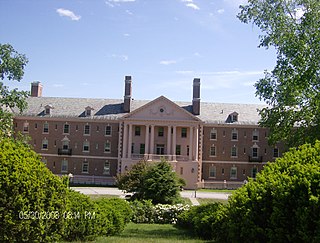
The Pleasant View Home is an historic senior citizen residential facility located at 227 Pleasant Street in Concord, New Hampshire, in the United States. On September 19, 1984, it was added to the National Register of Historic Places.
A Reader in a Christian Science church is a member of the congregation who has been elected to serve in one of two positions responsible for church services. Each week's sermon in Christian Science churches is outlined in the Christian Science Quarterly, prepared months in advance, and is the same in all Christian Science churches, worldwide. As a lay church, the congregation elects readers from the congregation and they serve as readers for a set period of time. The sermons consist of passages from the Bible and Science and Health with Key to the Scriptures by Mary Baker Eddy, and are studied as lessons during the week and read aloud to the congregation on the Sunday following.

The First Church of Christ, Scientist is the oldest Christian Science congregation in Toronto, Ontario, Canada. It is located at 196 St. George St. in The Annex neighbourhood, just north of the University of Toronto. It maintains a Reading Room at 927 Yonge Street north of Bloor. The church is a branch of The First Church of Christ, Scientist in Boston, Massachusetts, USA.

First Church of Christ, Scientist, built in 1901, is an historic Mission Revival-style Christian Science church located at 3606 Lemon Street in Riverside, California. It has been called: "the church that introduced Christian Science to Southern California." It was designed by noted Los Angeles architect Arthur Burnett Benton. On September 22, 1992, First Church of Christ, Scientist, was added to the National Register of Historic Places. It is still listed in the Christian Science Journal as an active Christian Science church.

First Church of Christ, Scientist is an historic redbrick 6-story domed Christian Science church building located at 13 Waterhouse Street, in Cambridge, Massachusetts. It was designed in 1917 by church member Giles M. Smith of the noted Boston architectural firm of Bigelow and Wadsworth, who patterned it after Thomas Jefferson's The Rotunda at the University of Virginia and the Pantheon in Rome. Due to cost constraints it was built in two phases between 1924 and 1930. The basement and ground floor levels topped by a belt course comprised the first phase, while the additional four stories and the massive dome comprised the second and final phase. The dome itself was designed and built by the noted Guastavino Fireproof Construction Company, which in 1898 had done the reconstruction of the dome in The Rotunda at UVA and the construction in 1906 of the dome of the Mother Church Extension in Boston. Guastavino used its patented tile arch system consisting of Akoustolith, a porous ceramic material resembling stone, on the interior, with limestone on the exterior. The tile was manufactured at its plant in nearby Woburn. In 1933 copper flashing was added to the exterior of the dome in order correct a leakage problem. An oculus provided light to the interior. The first services in the completed building were held on April 30, 1930, and after becoming debt free, it was dedicated on May 23, 1937.

The Life of Mary Baker G. Eddy and the History of Christian Science (1909) is a highly critical account of the life of Mary Baker Eddy, the founder of Christian Science, and the early history of the Christian Science church in 19th-century New England. It was published as a book in November 1909 in New York by Doubleday, Page & Company. The original byline was that of a journalist, Georgine Milmine, but a 1993 printing of the book declared that novelist Willa Cather was the principal author; however, this assessment has been questioned by more recent scholarship which again identifies Milmine as the primary author, although Cather and others did significant editing. Cather herself usually wrote that she did nothing more than standard copy-editing, but sometimes that she was the primary author.
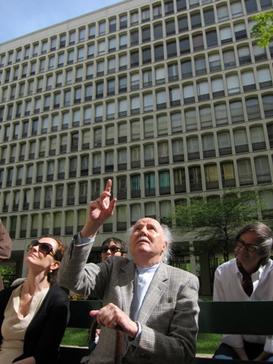
Araldo Cossutta was an architect who worked primarily in the United States. He worked at the firm I. M. Pei & Partners from 1956 to 1973. I. M. Pei has been among the most honored architects in the world. Cossutta was Pei's associate and ultimately his partner in the first phase of Pei's career. He was responsible for some of the firm's best-known designs from that era, including three that have received "landmark" designations in recent years. In 1973 he and Vincent Ponte left Pei's firm to form Cossutta & Ponte, which ultimately became Cossutta and Associates. The new firm designed the Credit Lyonnais Tower in Lyon, France (1977) and the Tower at Cityplace (1988) in Dallas, Texas, among other commissions.

First Church of Christ, Scientist, Brisbane is a heritage-listed site at 273 North Quay, Brisbane City, City of Brisbane, Queensland, Australia. It was designed by Lucas and Cummings, Architects. It was added to the Queensland Heritage Register on 11 March 2016.
























